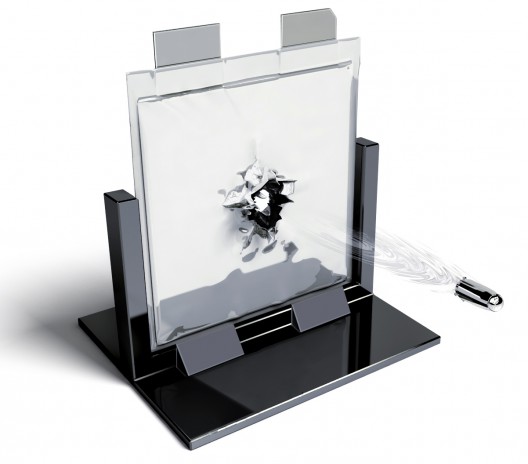Lithium battery puncture tests have provided many time-wasting moments on YouTube, presenting pyrotechnic displays in many versions. Most are explosive and fiery examples of what is referred to euphemistically as “rapid deconstruction.”
What if a battery could take a bullet and still offer superior energy, power and reliability? Kokam answered this question for the military, showing that its new NANO battery technology “do[es] not experience thermal runaway when… shot,” according to a June 13 announcement.

Artist’s conception of ballistic test on Kokam pouch cell. Let’s see the video!
Intended “for the defense industry for use in submarines, support vehicles, armed fighting vehicles, and unmanned systems,” the battery combines three lithium-ion chemistries – Lithium Iron Phosphate (LFP), Lithium Titanate Oxide (LTO) and Nickel Manganese Cobalt (NMC) – into a single battery,
Battery University explains the pros and cons of each chemistry:
LFP: Li-phosphate has excellent safety and long life span but moderate specific energy and elevated self-discharge.
LTO: Li-titanate excels in safety, low-temperature performance and life span. Efforts are being made to improve the specific energy and lower cost.
NMC: NMC has good overall performance and excels on specific energy. This battery is the preferred candidate for the electric vehicle and has the lowest self-heating rate.
Battery University has a rule of thumb that greater energy density usually coincides with greater volatility and vice-versa.
One thought, that combining these battery chemistries might cancel out the benefits of each, seems to be overwritten by the benefits of consolidation. The NANO battery can discharge at a 10 C-rate (Continuous) / 15 C-rate (Pulse) and charge at a 5 C-rate (Continuous) / 14 C-rate (Pulse). It can also withstand temperatures ranging from -40 to 60 degrees Celsius.
At the same time, Kokam seems a bit reticent about revealing energy or power density figures for this particular battery, although it does claim 260 Watt-hours per kilogram for its ultra-high energy density NMC cells.
Whether this kind of energy density can be achieved in the NANO battery remains to be seen, along with whether Kokam can bring this seemingly indestructible battery to the civilian market at an acceptable price.
